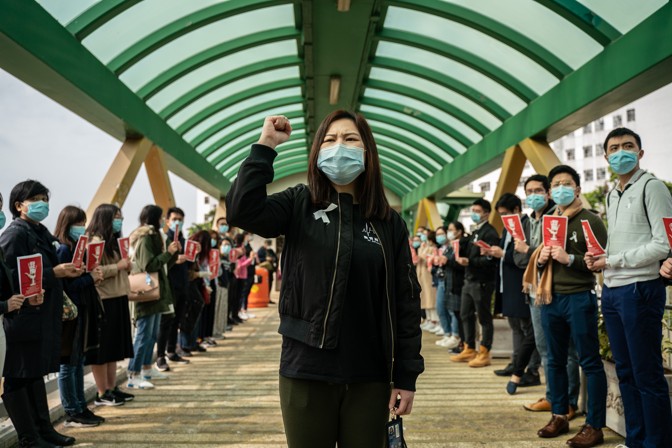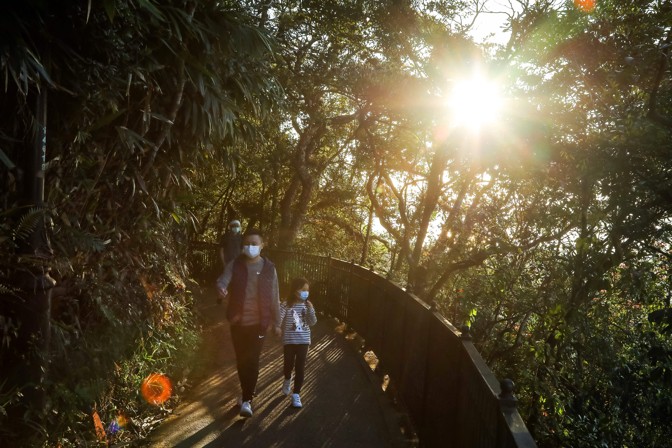It was January when I first heard about the mysterious viral pneumonia circulating in Wuhan, China. I had some major worries—was this SARS redux, or something else?—but also a small, selfish lament. I was eager to go back to Hong Kong, where I had been conducting research on its protest movement. A new epidemic there would likely mean that visiting the city anytime soon would be unsafe. I worried about my many friends there. I told them that I hoped to see them as soon as the outbreak was over.
It’s been five months, and I doubt Hong Kong will let someone like me in anytime soon. The city of more than 7 million people had no local cases for weeks until today; meanwhile, I live in the country with the worst outbreak in the world, the United States, with more than 80,000 known deaths from COVID-19 and without encouraging developments on the necessary measures to contain it. Hong Kong, by contrast, has had only four known deaths total from the coronavirus over the past many months. It recently stopped calculating the dreaded R(t)—the real-time transmission rate of the coronavirus—because, of course, you cannot calculate transmission rates without new cases. Hong Kong never even had a full lockdown (although it closed schools, which it plans to reopen soon). Meanwhile, I’m entering my sixth week under a stay-at-home order, with no robust exit infrastructure in place.
[Read: The real reason to wear a mask]
If there was a country that could have been expected to have a hard time with this virus, it was Hong Kong. It’s one of the most dense cities in the world, with crowded high-rise housing squeezed into almost every available space, and more cross-border traffic with China than anywhere else in the world. The region relies on an efficient but packed mass-transportation system—trains run every few minutes but many are stuffed to the gills during many hours of the day. There is little open public space, and little room to naturally spread out. Many of my favorite restaurants in Hong Kong seat diners elbow to elbow, knee to knee.
Unsurprisingly, Hong Kong has had a long history of epidemics. The 1968 flu pandemic that killed 1 million people around the world started in Hong Kong, and killed at least many thousands of the city’s residents, and became known as the Hong Kong flu. Hong Kong also lost the most people outside of mainland China to the 2003 SARS epidemic.
It wouldn’t have been shocking if, like many pathogens before it, this coronavirus had spread wildly through Hong Kong. The city is connected to Wuhan, where the pandemic started, via a high-speed-train line and many daily flights. More than 2.5 million people came to Hong Kong from mainland China just in January of 2020. The city also lacks a competent government with a strong basis of legitimacy. The people don’t have full voting rights and the region’s chief executive, Carrie Lam, who was hand-picked by Beijing, failed to muster an effective response when the protest movement engulfed the city in 2019. The region’s economy was already in recession before the pandemic, and things have worsened since. Lam is extremely unpopular, with a staggering 80 percent disapproval rating.
[Read: The problem with stories about dangerous coronavirus mutations]
Lam fumbled the response to the pandemic as well, reacting with ineptitude, especially at first. Hong Kong’s first coronavirus case was reported when she was having dim sum with world leaders in Davos, Switzerland, and there was an outcry over the fact that she did not quickly return. She dragged her feet in closing the city’s borders, and never fully closed down the land border with China. The hospitals suffered from shortages of personal protective equipment. Lam wavered on masks, and even ordered civil servants not to wear them. There were shortages of crucial supplies and empty shelves in stores, as well as lines for many essentials. In early February, the financial outlet Bloomberg ran an opinion piece that compared Hong Kong to a “failed state”—a striking assessment for a global financial center and transportation hub usually known for its efficiency and well-functioning institutions.
And yet there is no unchecked, devastating COVID-19 epidemic in Hong Kong. The city beat back the original wave, and also beat back a second resurgence due to imported cases. But unlike in Taiwan or South Korea, this success can’t be attributed to an executive that acted early and with good governance backed by the people.
[Derek Thompson: What’s behind South Korea’s COVID-19 exceptionalism?]
The secret sauce of Hong Kong’s response was its people and, crucially, the movement that engulfed the city in 2019. Seared with the memory of SARS, and already mobilized for the past year against their unpopular government, the city’s citizens acted swiftly, collectively, and efficiently, in effect saving themselves. The organizational capacity and the civic infrastructure built by the protest movement played a central role in Hong Kong’s grassroots response.
For example, during last fall’s district-council elections, Hong Kong protesters created many resources to guide and mobilize voters in what were otherwise local elections of little consequence, but that had become symbolically important in the middle of the protest wave. One key initiative was websites that provided information on candidates so voters could easily figure out who was pro-government and who was not—not always easy when the candidates were supposed to be discussing garbage collection, not Beijing’s attempts to limit Hong Kong’s constitutional protections. On the very day the first known coronavirus case in Hong Kong was announced, the same protest team behind the candidate information sites immediately created a new website—this time to track cases of COVID-19, monitor hot spots, warn people of places selling fake PPE, and report hospital wait times and other relevant information.

Many of the key information sources for Hong Kong protesters had been anonymous channels in the popular app Telegram and their own online forums. These anonymous formats protected the protesters from government repression but created a constant threat of misinformation, as someone could always pretend to be a protester or just be wrong or trolling. Consequently, the protesters learned to become incessant fact-checkers, used to looking up multiple sources and critically analyzing information. Now they turned their powers to critical analysis to the coronavirus: criticizing their own officials, as well as the World Health Organization, which did not advise wearing masks or travel restrictions, and China, which they saw as covering up the initial epidemic (they were right on all counts).
[Read: Keep the parks open]
In response to the crisis, Hong Kongers spontaneously adopted near-universal masking on their own, defying the government’s ban on masks. When Lam oscillated between not wearing a mask in public and wearing one but incorrectly, they blasted her online and mocked her incorrect mask wearing. In response to the mask shortage, the foot soldiers of the protest movement set up mask brigades—acquiring and distributing masks, especially to the poor and elderly, who may not be able to spend hours in lines. An “army of volunteers” also spread among the intensely crowded and often decrepit tenement buildings to install and keep filled hand-sanitizer dispensers. During the protest movement, I had become accustomed to seeing shared digital maps that kept track of police blockades and clashes; now digital maps kept track of outbr
eaks and hand-sanitizer distribution.
When the government refused at first to close the border with mainland China, more than 7,000 medical workers went on an unprecedented strike, demanding border closures and PPE for hospital workers. This strike was only possible because labor unions were formed during the protests. Now they came in handy for collective action. Protesters also tried to speak symbolically and increase awareness: They advocated wearing white ribbons to show support for medical workers and made art that demonstrated proper hand-washing and correct mask wearing, and that decried the mask shortage.
[Read: Hong Kong’s protesters finally have (some) power]
Some of the signals to the government were decidedly more confrontational. Through Telegram channels, “anti-epidemic actions” were threatened if the government did not respond to the virus by closing down borders. Explosives were discovered at border checkpoints between mainland China and Hong Kong, and flaming objects were thrown at the train tracks connecting the two countries. When the government hastily set up quarantine centers in dense neighborhoods without consulting the people who lived nearby, Molotov cocktails engulfed their (empty) lobbies, and the plans were scrapped. Later, the government set up quarantine facilities in much more sparsely populated holiday villages and many people used hotels to self-isolate.
Thanks partly to their long history of fighting epidemics, Hong Kong also has some of the world’s most prominent experts in infectious diseases. They were cautious about picking open fights with their government or with China, but were clear in prioritizing public health. Defying China’s pronouncements about lack of evidence for human-to-human transmission and ignoring the WHO, which relayed those pronouncements to the world, the experts stated from very early on that they suspected the disease was transmitted among people, and acted accordingly in their recommended safeguards. Despite the Hong Kong government’s continuing ban on face masks, Hong Kong’s health authorities openly credited the near-universal mask wearing among the people for avoiding a surge in cases.

Lam’s government eventually responded, but it was always a step behind the people. Hong Kong closed some border crossings throughout February but never fully shut down the border—by then, China was increasingly under a lockdown anyway, with limited travel anywhere. After increases in cases due to returning travelers, a screening center with testing was set up near the airport, along with a mandatory 14-day self-isolation period for all new arrivals (except those coming from China, Macau, or Taiwan)—but those measures didn’t happen until late into March, and testing for all incoming travelers did not even start until April 8.
Hong Kongers were so successful in their efforts that even the flu season ended six weeks earlier than usual. And now life returns to normal in Hong Kong: Museums and libraries are already open, and schools are reopening. People are able to go out and live their lives.
[Read: Venezuela’s coronavirus crisis is different]
The people kept up their vigilance in responding to new threats as well. A warning shot came from Singapore, which got its outbreak under control only to be faced with a major resurgence in April among the country’s crowded and densely packed low-wage migrant-worker dormitories. Volunteers in Hong Kong quickly started efforts to sanitize the subdivided flats that Hong Kong’s own working poor inhabit using UVC lights—free of charge to the poor residents. Now they are collectively organizing ordering takeout from beleaguered restaurants that suffered in the past few months, hoping to help them survive this crisis. As the government scales up its repression—arresting elected legislators and prodemocracy figures, and with scuffles in the legislative body that portend more crackdowns—the protesters have even started planning for protests. You can be sure they will show up wearing masks.
The people of Hong Kong know who’s actually behind the city’s success. A recent poll of 23 nations found that Hong Kong came in third-lowest in citizens’ scoring of their government’s handling of the crisis. They know their reality is difficult, but they also refuse to surrender to despair.
[Read: There’s one big reason the U.S. economy can’t reopen]
There’s a lesson here, as the United States deals with staggering levels of incompetence at the federal level. Stories have been written by doctors in major hospitals in the U.S. about how they tried to source masks in the black market and disguised PPE shipments in food trucks to avoid their seizure by the federal government. As Taiwan and South Korea show, timely response by a competent government can make the difference between surrendering to a major outbreak and returning to a well-functioning, open society without lockdowns or deaths. But Hong Kong also teaches that people aren’t helpless, even when their government isn’t helpful.
